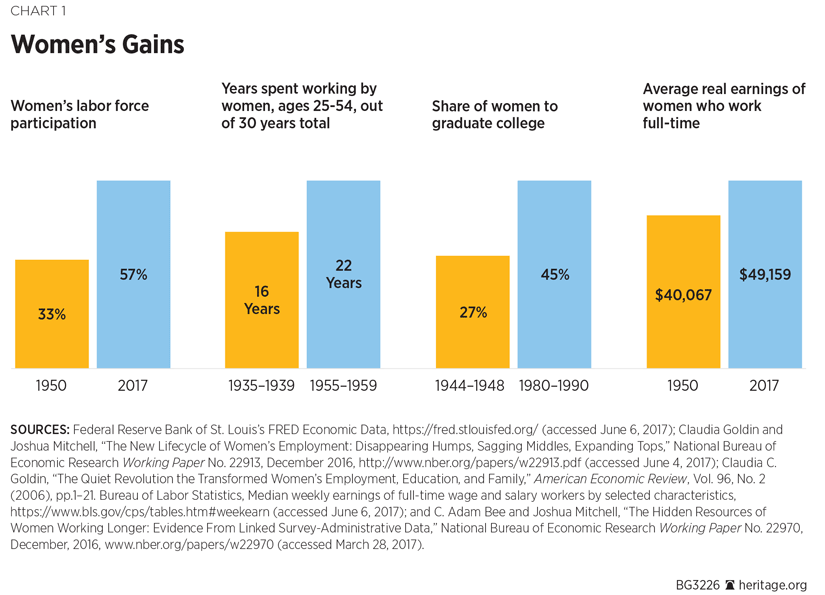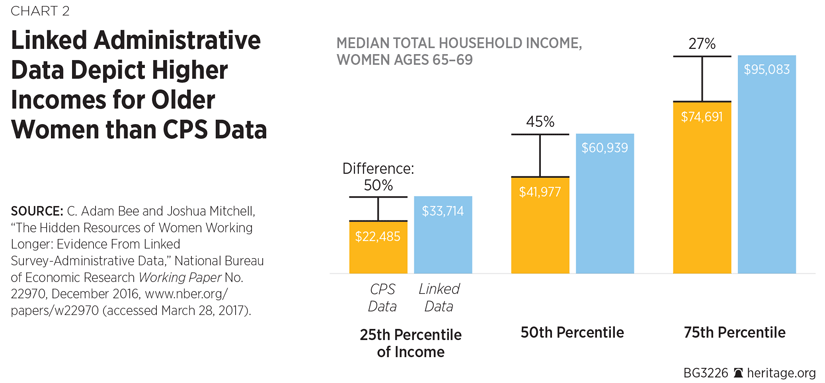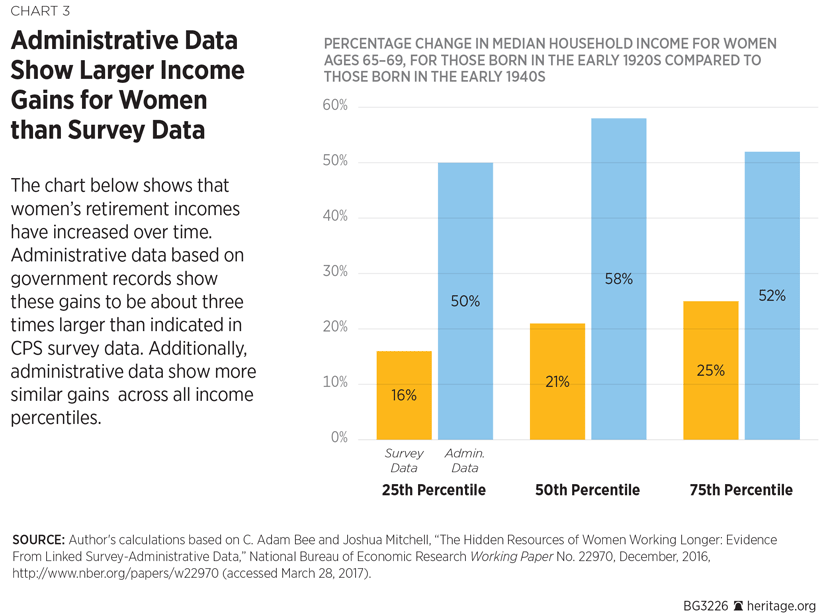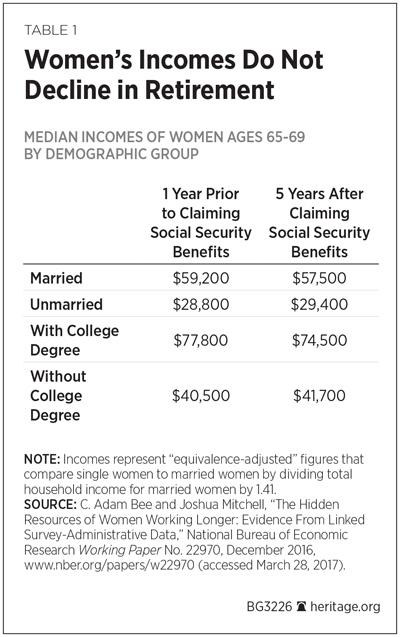Despite increases in women’s labor force participation and earnings over the past quarter-century, household survey data show that women today have only modestly higher retirement incomes than 25 years ago. However, that survey data significantly understate women’s retirement incomes and economic progress.[REF] As demonstrated by administrative data (taken from government records that researchers linked to survey-based data), most women do not experience a decline in income after they retire, and women’s retirement income has grown significantly over the past decades as a result of their increased labor force participation and earnings.
Survey data show that women are no more likely to receive retirement income—including from pensions, 401(k)s, and individual retirement accounts (IRAs)—than they were 25 years ago, that those who do have a retirement income have had only a relatively modest 21 percent increase, and that their incomes decline following retirement. Administrative data, however, show that women are twice as likely to have retirement income as they were 25 years ago, that those incomes have increased by 58 percent, and that their incomes remain remarkably steady after retirement. This revelation should prompt policymakers to focus less on gender-specific policies and instead enable personal savings and financial security for all Americans.
What the Typical Data Show
Multiple surveys and reports show that women have significantly lower retirement incomes than men, and that their higher incomes and greater labor force participation over the past decades have not translated into higher retirement incomes.
These reports and statistics do not line up with the rise in women’s labor force participation and earnings, which should translate into higher retirement incomes. It turns out that women actually do have higher retirement incomes than in the past, but the most commonly used data sources do not capture these gains.
The Current Population Survey’s Annual Social and Economic Supplement (CPS ASEC) is the nation’s official source of income and poverty statistics. The CPS ASEC questions a sample of individuals about their income and spending habits, with a goal of capturing information on regular streams of income. As such, the CPS ASEC asks respondents whether they “receive[d] any pension or retirement income” (other than Social Security or Veterans benefits).
From a respondent’s perspective, this question pretty obviously includes defined benefit pensions that provide monthly income, but it does not necessarily cover defined contribution plans, such as 401(k)s and IRAs. Individuals tend to withdraw defined contribution income on an as-needed basis, often with fewer and more irregular withdrawals. As more and more employers and their workers have shifted from defined benefit to defined contribution retirement plans, surveys such as the CPS ASEC fail to capture retirees’ full incomes. Moreover, studies show that workers generally do not fully understand their own pension or retirement plans and consequently may underreport their retirement incomes.[REF]
The CPS ASEC underwent a redesign in 2014 to improve its accuracy in capturing defined contribution retirement income in particular.[REF] Data based on the redesign are not yet available, so it is unknown if the redesigned CPS ASEC will capture retirement incomes more accurately.
A Better Data Source for Retirement Income
While survey data contain significant underreporting of retirement income, administrative records, such as those that individuals file with the IRS and the Social Security Administration (SSA), provide a more accurate measure of retirement income. This is because the line-item information required tends to be more specific than questions that can include multiple types of income, and potential penalties for false reporting encourage individuals to report the requested information accurately.
In an attempt to get a better measure of retired women’s actual incomes, the authors of a recent study, “The Hidden Resources of Women Working Longer: Evidence from Linked Survey-Administrative Data,” merged survey data from the Survey of Income and Program Participation (SIPP) and the CPS ASEC with administrative data on earnings and benefits from the IRS and SSA.[REF] These data sources allowed the authors to examine five sources of income, including Social Security and Disability Insurance benefits, Supplemental Security Income, interest and dividends, earnings, and retirement income (401(k), IRA, and pension benefits).
The authors then compared self-reported data from the CPS to a SIPP-linked survey-administrative dataset. Overall, the linked administrative data showed significantly greater economic progress for older women than the most widely reported survey measures.
Women’s Gains
Women’s labor force participation increased significantly throughout the 20th century, from only 33 percent in 1950 to 57 percent today.[REF] Women also remain in the labor force longer than in the past. Women born between 1935 and 1939 worked an average of 16 out of 30 years between the ages of 25 to 54, while women born between 1955 and 1959 worked an average of 22 out of 30 years.[REF]
Women are also more likely to graduate from college, with only 12 percent of women born between 1921 and 1925 having attended and graduated from college, compared to 27 percent of those born between 1944 and 1948,[REF] and 45 percent for women born in the 1980s.[REF] Women today are also more likely to have careers (in contrast to simply working at a job) than in the past.[REF] Finally, women have significantly higher earnings today than at any point in history. The average real earnings of women who work full-time increased by 23 percent from 1984 to 2016, from $40,067 to $49,159. (Over that period, men’s real earnings increased by only 1 percent.)[REF]
Taken together, these gains translated into greater access to employer-sponsored pensions and retirement plans as well as IRAs, all of which should improve women’s financial security in retirement. However, the most widely-reported data on retired women’s financial circumstances show little progress over the past decades. Recent findings suggest that apparent lack of progress is the result of data deficiencies that do not capture women’s actual economic gains.

Actual vs. Reported Retirement Incomes
Receiving Retirement Income. The older people get, the more likey they are to draw on retirement income from a pension, 401(k) plan, or other source. (Retirement income as defined here excludes Social Security and Veterans Benefits.) As younger cohorts of women have increased earnings and attachment to the labor force, the rate of receiving retirement income will increase over time.
The CPS ASEC survey, however, shows little change in the rate of retirement income receipt for women ages 65 to 69 over the past 25 years. In fact, it shows a slight decline, from 29 percent of women in the age range reporting retirement income receipts in 1984 compared to 26 percent in 2007. In contrast, the linked administrative data show a near-doubling of retirement income receipts for women ages 65 to 69, from 23 percent in 1984 to 45 percent in 2007.[REF] By age 70, as the administrative data show, at least 50 percent of women receive retirement income, compared to only about 30 percent reported in the CPS ASEC data.[REF]
Consequently, the administrative data show that households have significantly more overall retirement income than reported, as well as greater increases in retirement income.
Amount of Retirement Income. On average, the linked administrative data reveal that total median household retirement income for women ages 65 to 69 was $60,939 in 2007, compared to $41,977 reported in the CPS ASEC. Differences in incomes between the two data sources are largest for lowest-income households. At the 25th percentile of earners, the gap is 50 percent; the CPS ASEC reveals a median income of $22,485, while the linked data show $33,714. At the 50th percentile, the gap is 45 percent; the CPS ASEC reveals a median income of $41,977, while the linked data show $60,939. At the 75th percentile, the gap is 27 percent; the CPS ASEC reveals a median income of $74,691, while the linked data show household income of $95,083.

Growth in Retirement Income. According to data from the CPS ASEC, median household income for women ages 65 to 69 grew only 21 percent for women born in the early 1920s and those born in the early 1940s.[REF] However, administrative data show that median household incomes for women ages 65 to 69 grew nearly three times as much, by 58 percent.[REF] Moreover, the administrative data show relatively even gains across income groups, while the CPS ASEC data show larger retirement income gains among higher-income households. At the 25th, 50th, and 75th percentiles of income, the administrative data show respective gains of 50 percent, 58 percent, and 52 percent, while the CPS ASEC data show less-close gains of 16 percent, 21 percent, and 25 percent.[REF]

Growing Divergence in Income Data Over Time. The gap between retirement income reported in the CPS ASEC survey and that found in administrative records has risen over time. This is presumably due in large part to the shift from defined benefit pensions to defined contribution pensions, which survey data—the CPS ASEC in particular—do not capture adequately. In 1989, median income in the linked administrative data was 11 percent ($3,900) higher than reported in the CPS ASEC. By 2007, that gap grew to 45 percent or $19,000.[REF] This underreporting takes place across all households, not just for women.
No Drop in Income After Retirement
In addition to revealing larger income gains for women as a result of their increased labor force participation and earnings, the administrative data also reveal that most women’s incomes do not decline after they retire. According to linked administrative data, total median income for women remains virtually flat between the periods of one year before claiming Social Security benefits and five years after claiming.[REF] This finding is in contrast to past research that shows a decline in retirement income based on data from the CPS ASEC and other surveys.
While incomes of married women and those with a college degree decline slightly upon retirement (from $59,200 to $57,500 for married women, and from $77,800 to $74,500 for women with a college degree), incomes for unmarried women and those without a college degree actually rise slightly (from $28,800 to $29,400 for unmarried women, and from $40,500 to $41,700 for women with no college degree).[REF] These are important findings for policymakers who seek to fix or alleviate an alleged shortfall in retirement incomes for lower-income and unmarried women.

Conclusion
Data are important, as they help drive informed decisions, but data that reveal a false narrative can lead to faulty policies. When it comes to women’s retirement security and economic gains, the widely reported survey data are wrong. In reality, women’s incomes do not decline once they retire, and women have achieved significant growth in retirement incomes over the past decades as a result of their increased participation in the labor market and their increased earnings. Administrative data show that retired women have achieved two to three times the amount of income growth as reported in survey data. This revelation should lead policymakers to focus on policies that better enable personal savings and financial security for all Americans, as opposed to crafting policies aimed exclusively at women.
—Rachel Greszler is Research Fellow in Economics, Budget, and Entitlements in the Thomas A. Roe Institute for Economic Policy Studies, of the Institute for Economic Freedom, at The Heritage Foundation.



